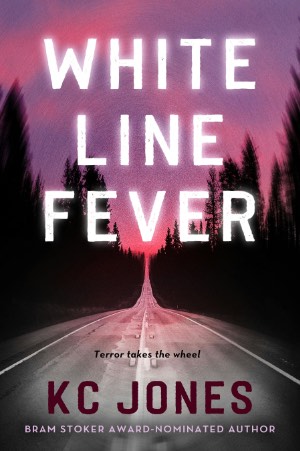
White Line Fever
White Line Fever by KC Jones is an ode to Stephen King. There are multiple references in the novel to several of King’s works, ranging from a vehicle referred to as “The Silver Bullet” to Stanley Kubrick’s film version of The Shining. Thematically, White Line Fever is primarily a love letter to King’s classic It, a book that focuses on a group of friends traumatized by events that happened in their youth. In Jones’s narrative, four gal pals in their thirties embark on a road trip aimed at bolstering the spirits of the brokenhearted protagonist. She carries the most emotional baggage, but each of the friends has unresolved personal demons. Those figurative demons become literal as an unplanned detour forces the foursome into confrontation. Author Jones initially envisioned the narrative as a screenplay and, with its striking visual depictions, the novel could easily be adapted into a movie. Jones graduated from UNLV with a degree in film production, and cinematic influence is pervasive in the writing style.

Which isn’t to say that the author is lacking when conveying characters’ inner thoughts and feelings. For example, when protagonist-narrator Livia discovers evidence of her husband’s infidelity, her previously perceived worldview is altered: “The entire neighborhood had changed. Spoiled. Houses leered disapprovingly of my commotion, and faceless shapes watched from darkened windows. The generally friendly German shepherd next door barked at me, pacing in agitation behind his fence. The yards were manicured to the point of being hostile — all razor-edged lines and unnaturally green grass and landscaping boulders so out of place they may as well have dropped from the sky. Garden gnomes glowered from hedged corners; a child holding a basketball gaped at me from a driveway as I roared past. The gate opened automatically as I neared, squeaking and groaning on its hinges like the portcullis of some walled fortification.” The passage occurs early in the book, setting up Livia’s frame of mind as a facet of her lifestyle façade crumbles. It gives the reader a preview of how easily perception can be manipulated by internal and external factors, an introduction of sorts to the infernal encounters yet to come.
In addition to the Stephen King influence, there’s a lesser but nonetheless relevant connection to the A Nightmare on Elm Street movies. The focal characters in White Line Fever are repeatedly assaulted by an entity who “feeds on things that haunt people,” mentally transporting them to a dreamlike environment where they face off the manifestations of their worst nightmares. They can be snapped out of the loathsome scenario by some sort of external shock or an act of defiance. The entity, labeled a “Harrowling” because it feeds on suffering, gets into people’s heads much like Freddy Kruger does. In the case of Livia, her nightmarish relationship with her father provides ample material for the entity to consume.
Livia’s friendship with her three fellow travelers sustains her in the battle against the supernatural villain, much as as it did when they were all youthful, trying to navigate the perils of inept (at best) or dangerous (at worst) parents. Many of the novel’s best scenes are flashbacks to the days when the Scoundrels, as the girls called themselves, got into merry mischief and gave each other support when adults would not or could not provide it. Very Stephen King.
White Line Fever, published by Nightfire, is the second novel by KC Jones. The first, Black Tide, was nominated for the 2022 Bram Stoker Award in the category of Superior Achievement in a First Novel. It wouldn’t be at all surprising if Jones receives another nomination before too long.

